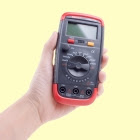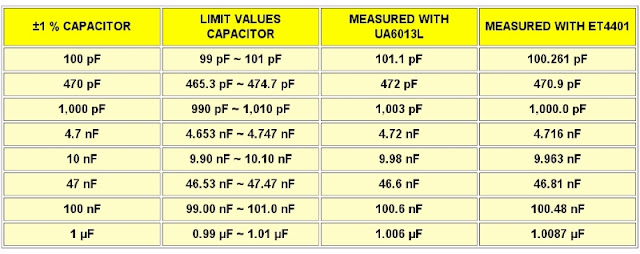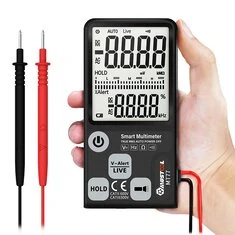
|
Although you can measure capacitors with most modern multimeters, capacitance meters are still offered. So there is a market for them. We tested one of the cheapest types, the UA6013L from Uyigao. |
Getting to know the UA6013L from Uyigao
What is the UA6013L?
The UA6013L is a capacitance meter from the Chinese Uyigao Technology Co., Ltd. (https://www.uyigao.cn/en/index.html) from Shenzhen. This company produces electronic measuring equipment, including multimeters, clamp meters, LCR meters, capacitance meters, thermal cameras and a lot of sensor meters for light, sound, vibration, speed and gases.
The UA6013L is the cheapest capacitance meter, available from AliExpress for prices starting at €10.11 plus about €6.00 shipping. The meter measures capacitors in nine ranges from 200 pF to 20 mF.
Appearance of the UA6013L
The meter is housed in an attractive bicolour housing with the black part made of hard plastic and the red part made of soft plastic. The slip-proof red part ensures that the meter stands firmly on the table and does not move with every push of a button. On the back is the battery compartment for the 9 V battery (not included) and a fold-out back support.
The meter measures 148 mm x 75 mm x 33 mm and fits comfortably in the hand. The rotary switch selects one of the nine ranges. The device does not have automatic ranges. Via two push buttons you can freeze the display (HOLD) and briefly switch on the backlight of the display. After about four seconds, the backlight slowly fades away. A small rotary potentiometer (ADJ) allows you to zero the reading with open terminals. In practice, this is only necessary in the lowest measuring range of 200 pF.
Between the two push buttons there is a connector with 2 x 4 holes in which you can clamp the two wires of the capacitor to be measured. Of course, you can also connect the capacitor to the meter by means of the two supplied short measuring cables.
 |
| The appearance of Uyigao's UA6013L. (© Uyigao) |
The delivery of the meter
The meter comes in a neat cardboard box which, strangely enough, shows the picture of a completely different meter. The manufacturer uses, to save costs, one and the same box for six different measuring devices! Very convenient, but when you take the cardboard box out of the black plastic wrapping, you think at first (as we did) that the supplier has sent the wrong meter!
The two measuring leads are only 20 cm long and fitted with sturdy crocodile clips. In our opinion, these could have been one size smaller. The box contains a good manual in English, although the meter is so easy to operate that this is actually superfluous.
 |
| The scope of delivery of the UA6013L. (© 2021 Jos Verstraten) |
The three views and the mystery of the three banana jack sockets
In the photograph below, we have combined the front, side and rear views.
You can see that the meter has three banana sockets. The middle 'CX-' is meant for connecting the negative pole of electrolytic capacitors, that is obvious. The left and right ones both carry the notation 'CX+'. The left one says '200 mA FUSED', the right one 'MAX 36VDC'.

The meaning of this is completely unclear and is not explained in the manual either. We suspect that the manufacturer not only uses one and the same cardboard box to package various measuring devices, but also uses one and the same housing. The UA33B multimeter shown in the picture of the box has exactly the same position of buttons, rotary switch and 4 mm sockets. To save costs, the housing of that meter was probably also used for the UA6013L and the superfluous banana socket on the right was assigned a completely irrelevant function. That saves yet another expensive injection mould!
 |
| The three views of the UA6013L. (© 2021 Jos Verstraten) |
The specifications of the UA6013L
According to the manufacturer, this capacitance meter has the following specifications:
- Display: 3½ digits (1999)
- Refesh rate: 3 measurements per second
- Accuracy range 200 pF: ±[0.5 % ±20 digit], 800 Hz
- Accuracy range 2.00 nF: ±[0.5 % ± 20 digit], 800 Hz
- Accuracy range 20.0 nF: ±[0.5 % ± 20 digit], 800 Hz
- Accuracy range 200 nF: ±[0.5 % ± 20 digit], 800 Hz
- Accuracy range 2.00 μF: ±[0.5 % ± 20 digit], 800 Hz
- Accuracy range 20.0 μF: ±[0.5 % ± 20 digit], 80 Hz
- Accuracy range 200 μF: ±[0.5 % ± 20 digit], 8 Hz
- Accuracy range 2.00 mF: ±[2.0 % ± 20 digit], 8 Hz
- Accuracy range 20.0 mF: ±[4.0 % ± 20 digit], 8 Hz
- Dimensions: 148 mm x 75 mm x 33 mm
- Weight: 193 g
- Power supply: 9 V battery
The electronics in the UA6013L
The printed circuit board in the housing
To open the UA6013L, you first have to remove the flexible red part of the housing and then unscrew two bolts on the back. You can then open the case by flipping open the two parts. The housing is completely filled by the battery compartment and the PCB shown in the photo below.
We recognise some well-known types from the CD4000-family: CD4017, CD4510 and CD4066. The CD4017 is a decade counter with ten decoded outputs. The CD4510 is a BCD up/down counter. The CD4066 is, of course, the well known quadruple analogue switch. Furthermore, the PCB contains two dual op-amps TL062 and LM358 and a FET of type K30A.
This strange combination of active elements gives no indication of the measurement method that was used for the UA6013L.
 |
| The circuit board in the UA6013L. (© 2021 Jos Verstraten) |
How does the circuit work?
According to the specifications, the device applies an AC voltage across the capacitor at frequencies of 8 Hz, 80 Hz or 800 Hz. The oscillogram below shows the signal across a 100 nF capacitor. The yellow line represents the zero level. The frequency of the signal is 818.3 Hz, the peak-to-peak value 2.260 V. The only thing that varies when you change the value of the capacitor is that the voltage level of the bottom of the signal increases or decreases. So the peak-to-peak value of the signal is an indication of the value of the capacitor. The software will probably convert this value to a capacitance value.
In the tested specimen, the two other measurement frequencies are 81.83 Hz and 8.183 Hz. It is clear that electrolytic capacitors are well polarised if you connect the negative pole to the 'CX-' bus of the meter.
 |
| The voltage across a 100 nF capacitor. (© 2021 Jos Verstraten) |
Uyigao's UA6013L tested
Introduction
For testing a capacitance meter we have a set of capacitors with a tolerance of ±1% at our disposal and our own RLC meter ET4401 from EastTester. This has, according to the specifications, a basic accuracy of ±0.20% when measuring capacities. The UA6013L has a specified accuracy of ±0.50%. Both values are too close to each other to consider the reading of the ET4401 as an absolute reference. That is why in the three following tables the reading on the ET4401 is only given as a check, which is of course very useful to judge the accuracy of the UA6013L in the tables of ceramic and electrolytic capacitors, of which the tolerance is not specified.

Measuring the ±1.0 % capacitors
This is a set of metallised polypropylene film capacitors from Vishay Roederstein, type MKP-1837. We bought eight such capacitors, from 100 pF to 1 μF. These capacitors are measured with the UA6013L and the ET4401. For each measurement, the reading is noted after ten seconds. After all, with most C-meters, it takes a certain time for the reading to stabilise. The ET4401 measures in four-wire technique and is therefore not affected by parasitic capacitances of the measuring leads. To avoid this with the UA6013L, the capacitors are plugged into the connector on the front panel of the meter. The results are summarised in the table below. The 'LIMIT VALUES' indicate the lower and upper limit of the real value of the ±1.0 % capacitor being measured.
From the table you can see that there is only one capacitor that is measured by the UA6013L outside its limits. Quite an achievement for such a cheap meter!
 |
| Measuring our ±1.0% capacitors. (© 2021 Jos Verstraten) |
Measuring small ceramic capacitors
The table below shows the results of measuring small ceramic capacitors with both meters. In the measuring range '200PF' that you have to switch on, it is absolutely necessary to adjust the reading with the 'ADJ' potentiometer to '00.0' before connecting a capacitor to the meter.
The deviations between both meters are relatively small, you can conclude that the UA6013L also gives fairly reliable results in this measuring range.
 |
| Measuring small ceramic capacitors. (© 2021 Jos Verstraten) |
Measuring electrolytic capacitors
Elco's are notorious for their large tolerances, deviations of ±20% are no exception. Moreover, they are very difficult to measure accurately with most measuring devices. This is due to the fact that most measuring methods are based on charging or discharging the capacitor with a constant current and measuring how long it takes the capacitor to do so. However, this measurement method does not take into account the leakage current of the capacitor, which is unpredictable. Two identical electrolytic capacitors can have a leakage current that differs by a factor of ten. Because the ET4401 uses a different measurement method, we are quite sure that this meter can also accurately measure electrolytic capacitors. If you look at the table below, you will notice that the tested UA6013L measures much higher values than the ET4401 at all values above 1 μF.
 |
| Measuring electrolytic capacitors. (© 2021 Jos Verstraten) |
Our verdict on the UA6013L from Uyigao
This meter has pleased us! If you need to measure a capacitor occasionally and are only interested in the value and not in the ESR, X, D, Q, Φ or other exotic specification of the component, you can rely on the UA6013L to measure the most commonly used capacitor values quite accurately.

Mustool MT77 Large Screen Multimeter
